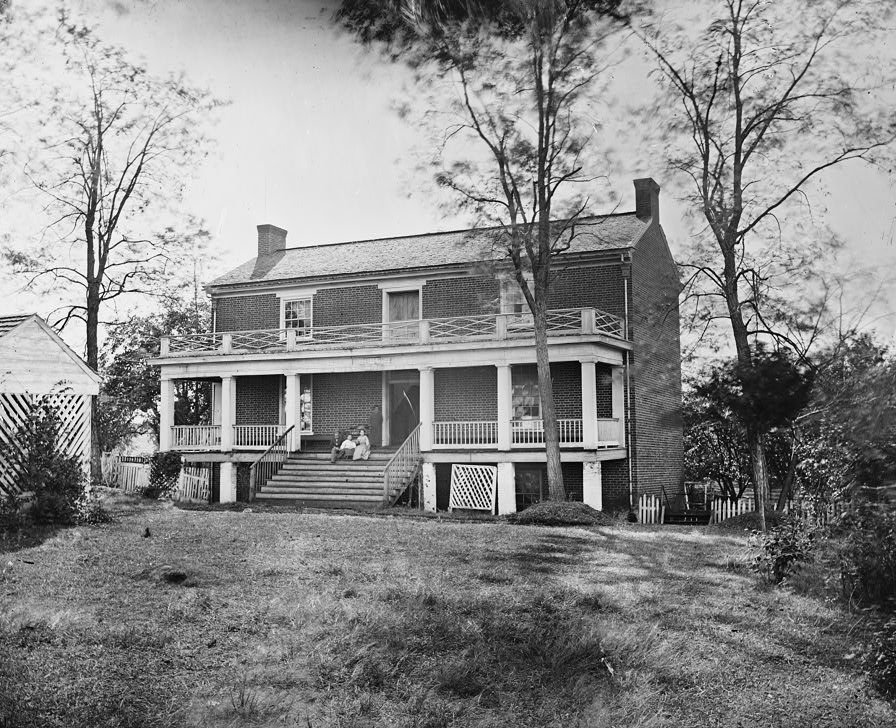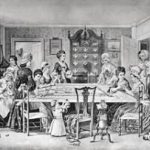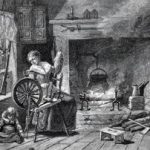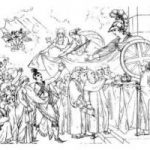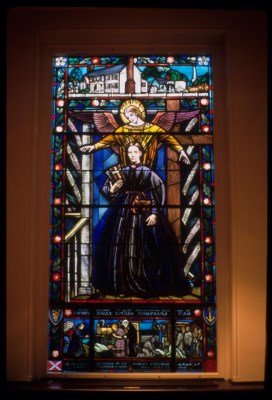Women Who Lost Husbands in the Civil War
Approximately 620,000 soldiers died in the American Civil War. The Union lost around 360,000 soldiers – 110,000 killed in combat; the Confederacy lost around 260,000 men – 93,000 killed in combat. Disease killed the rest. While not all of these soldiers were married, the War created an unprecedented number of young white widows, many of whom had been married for a very short time.
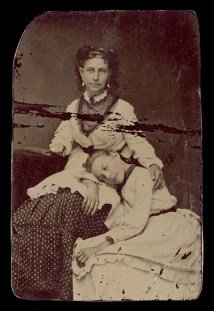
Tintype of Union Widow Adelia Springer and her daughter
For many Confederate widows, the war was an extremely close and personal experience, as battles and armies brought death, destruction and hardship into their states, their communities and sometimes their backyards. Many Confederate widows supported the Confederacy during the war and memorialized it after the surrender.
Union widows, on the other hand, received the honor and respect of a nation at the close of the war, for they had sacrificed their husbands to a winning cause. And yet, in spite of their political differences, the grieving process of Union and Confederate white widows was similar. The loss of a husband and the struggle to live within the limitations society placed on them affected all widows, regardless of location.
Union Widows
From the onset of the Civil War, the US government granted pensions to widows of soldiers who died in service of the Union Army, approximately 360,000 total. The Pension Dependent Act of 1890 extended benefits to the widows of honorably discharged veterans serving for at least ninety days. A widow had to provide proof of the soldier death; she could not have any means of support other than her own labor; and Their marriage must have occurred before June 17, 1890, the date of the Act.
Adelia Springer
On August 28, 1853, Miss Adelia Jones (age 19) married Joseph Springer (age 25) in Battle Creek, Michigan. Joseph Springer served as a private in Company A, Seventh Michigan Cavalry, and died at Andersonville Prison in October 1864. Adelia had four children under the age of 16 when she applied for her pension in June 1865.
In July 1872 Adelia married Jason Webb, and she was dropped from the pension rolls. Webb left their home in Battle Creek, Michigan in the fall of 1872, and Adelia never saw him or heard from him again. Presuming Webb dead, she married Washington A. Fish January 25, 1883. When Fish died twenty-two years later, Adelia applied for restoration to the pension rolls for her first husband’s service. Adelia had no children by either Webb or Fish.
After Fish died on August 11, 1915, Adelia, now 77, applied for restoration to the pension rolls based on her first husband Springer’s service. Because Webb had disappeared and was not confirmed dead, the Pension Bureau ordered a special examination to investigate the legality of Adelia’s widowhood. In affidavits, Adelia and her daughter Elva claimed they had received a letter in 1874 notifying them of Webb’s death. Signed A Friend, it had enclosed a five-dollar gold piece and stated that Webb had asked that the coin be sent to Elva.
Special Examiner F. L. Churchill reported that Adelia was old and feeble and had a poor memory, and that she relied on her daughter and the local notary to see to her case. Churchill descried the notary as a “bungler” who drank too much and the daughter as possessing only a fair reputation and very anxious to get the pension. Although Churchill could not find evidence of Webb’s death, he believed Adelia truly thought he was dead when she married Fish. In a 1916 affidavit, Adelia’s son Charles described Webb as a shiftless fellow.
The Pension Bureau’s Board of Review concluded in September 1916 that Webb probably deserted Adelia “for reasons which would have warranted a divorce.” The discovery of another rejected pension claim from the widow of a Jason B. Webb led to more questions. Churchill noted that Adelia’s description of Webb closely corresponded with that of this man who had served in Company G, 14th U.S. Infantry, from 1872 to 1877, and he recommended further examination.
When Special Examiner Milford Brower interviewed Rosanna Webb, the other widow, she told him she had no reason to believe Webb had been married before. She had applied for a pension after he died in 1907, testifying that she and Jason had married in 1876 and had three children. When the examiner showed her a daguerreotype provided by Adelia’s daughter Elva, Rosanna identified the man as her husband.
In May 1917, Adelia’s pension claim was rejected because she had “contracted more than one marriage since the death of the soldier,” and had failed to establish that her marriage to Webb had ended legally either by death or divorce. Had she filed for divorce on grounds of desertion, she likely would have secured the restoration of her pension.
Adelia Springer Webb Fish died November 28, 1920 in Battle Creek, Michigan at age 87.
Confederate Widows
Approximately 260,000 Confederate soldiers died in the American Civil War. While not all of them were married, the Civil War created an unprecedented number of young white Southern widows, many of whom had been married for a very short time. Many had hurried to marry their loved ones before they marched off to war.
Civil War widows in Virginia were defined as women married to Confederate soldiers who died during the American Civil War (1861–1865). The numbers of these women are difficult to determine, but they were relatively young and their marriages had often been brief. About half of all widows remarried during or after the conflict, especially the younger ones, but because of the war’s toll on young men, they were likely to marry men older or younger than themselves.
Beginning in 1888, some were eligible for a state pension of $30 per year, provided they did not have an annual income exceeding $300, did not own personal property in excess of $1,000, and had not remarried. About 1,900 Virginia women successfully filed for such pensions from 1888 to 1899.
With the death of their husbands, these women were left with little or no financial assets. To aid these widows as well as the wives of soldiers who were still living, in 1863 the Virginia General Assembly instructed the county courts to provide these women and their children with food. The county governments did their best to accomplish this task, but were hindered by the lack of supplies and raging inflation in the Confederacy.
Using the names of widows found in the death claim records, it appears that slightly less than half of Virginia’s Civil War widows remarried either during or immediately after the war. About
three-quarters of those who were under the age of twenty when the war began found new husbands. Middle-aged widows were far less likely to remarry, but they were more likely to own property as well as to have adult children who could help provide for them.
Given Virginia’s overwhelmingly rural economy, there were few opportunities for the widows to work outside the home. Those who did find employment tended to work in traditionally female occupations such as dressmaking. While very few Virginia widows could have survive on the small pensions they received, it surely would have been a welcome compensation to relatives with whom many of these increasingly elderly women often resided.
 Image: Girls from Ann Smith Academy at Stonewall Jackson’s grave in Lexington, Virginia
Image: Girls from Ann Smith Academy at Stonewall Jackson’s grave in Lexington, Virginia
In May 1863, the Confederacy mourned perhaps their most popular leader, Thomas J. Stonewall Jackson. After lying in repose at the State Capitol in Richmond, his remains were moved to Lexington amid a military procession and eventually interred at the Virginia Military Institute, where he had been a professor before the War. His widow, Mary Anna Morrison Jackson, never remarried, and she wore black mourning clothes until the day she died.
Hetty Cary
On January 19, 1865, Richmond beauty Hetty Cary married Confederate General John Pegram. John returned to duty soon thereafter and on February 5 he received a shot in the chest and died almost instantly. Exactly three weeks from the date of her wedding, Hetty found herself in the same church, with the same people, the same minister, walking down the same aisle, for the funeral.
Diarist Judith McGuire wrote:
Again has St. Paul’s, his own beloved church, been opened to receive the soldier and his bride – the one coffined for a hero’s grave, the other, pale and trembling, though still by his side, in widow’s garb.
After the ceremony, the attendees took a “slow pilgrimage” up a steep bluff to the Pegram plot in the Hollywood Cemetery. Hetty “was like a flower broken in the stalk,” so heartbroken that earlier she had to be torn from the body “almost by force.” Three weeks a wife, Hetty, just 29 years old, would remain a widow for more than 15 years.
New Orleans Widows
The city of New Orleans did not take well to the Union takeover led by General Benjamin Butler in 1862. The strong tension between General Butler and the women of the city eventually led to Butler’s Order 28, proclaiming that any woman showing disrespect for the Union military could be treated as a prostitute. This violence towards women created a strong backlash against the Union army, and Butler was removed in December 1862.
When the Civil War ended, there were so many women without husbands and children without fathers in New Orleans that an influx of fundraising for widows soon followed. Former Confederate General John Bell Hood was among the high profile donors. After the war, he moved to New Orleans and dedicated part of his time to allocating resources for these women.
Organizations dedicated to widowed women sprang up across the city, including the Union Benevolent Association Asylum, which received donations via letters to the public in local newspapers and grants from the government. By 1871, there were at least thirty different groups dedicated to raising funds, offering services, and providing temporary residences for widows within New Orleans alone.
Dodson and Nellie Ramseur
At a time when the average woman gave birth to eight or nine children in her lifetime, it is not surprising that the Civil War created many pregnant widows. Confederate General Stephen Dodson Ramseur was ecstatic to hear the news of his beloved young wife’s first pregnancy but, he wrote, “the greatest trial of my life to be separated from you now!”
On October 15, 1864, a message came through the military telegraph lines telling the general that Nellie Ramseur had given birth and all was well, but did not include the gender of the baby. Ramseur wrote home to ask whether he had a son or a daughter, signing the letter “with love inexpressible.” Three days later, the proud father wrote out his will.
In a surprise attack at dawn on October 19, Ramseur and his brigade participated in the rout of two thirds of the Union army at the Battle of Cedar Creek. Ramseur’s troops struck hard and fast at Federal positions along the Creek. Ramseur displayed great bravery in rallying his troops, but he was mounted conspicuously on horseback and drew continuous fire.
In the swirling combat, Ramseur was shot through both lungs and was taken to Belle Grove Mansion, headquarters of Union General Philip Sheridan. Friends from his West Point days, including including Union General George Armstrong Custer, rushed to Ramseur’s bedside. Ramseur died of his wounds at 10:20 the next morning, October 20, 1864, still unaware that he was the father of a beautiful baby daughter.
Widow’s Weeds
Once it was verified that the soldier husband was dead, the long ordeal of mourning began. Black silk dresses and heavy veils were expensive and sometimes hard to find. South Carolinian Emma Holmes believed that a grieving widow was “the saddest of sights” and hated to see “a young girl of beauty, talents, refinement and wealth, whose mind is so clouded by melancholy as to be oblivious of the realities of the present.”
The inability to purchase proper mourning garb plagued women of lower classes. Because of economic hardships, mourning was a luxury that these women could not afford. Diarist Judith McGuire described “one sad girl” who was “too poor to buy mourning” due to “fallen fortunes.” Another, who could not afford to buy a mourning wardrobe, dyed all the clothing she owned black in order “to make them suitable.”
On December 18, 1862, Lucy Breckinridge found herself surrounded by “14 ladies dressed in black” and remarked, “There were so many ladies there, all dressed in deep mourning, that we felt as if we were at a convent and formed a sisterhood.” During the Civil War so many women wore black that it often seemed that the entire nation was cloaked in dark shadows.
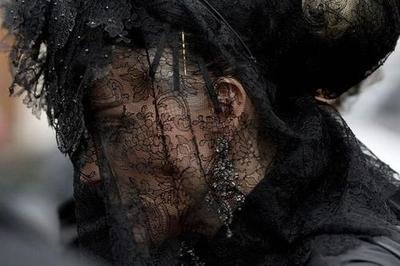 The ideal Civil War widow wore all black clothing and mourned for a minimum of two and a half years. The widow’s most important task was to bring her husband’s body home for burial. The idea of a body resting far from home or in enemy soil was unacceptable. A woman’s mourning work began once she had a place to mourn. If a widow could manage to determine the location of the body, she should “seek a grave for the dead” at home, “close by those he loved, among kindred and friends in the fair sunny land he died to defend.”
The ideal Civil War widow wore all black clothing and mourned for a minimum of two and a half years. The widow’s most important task was to bring her husband’s body home for burial. The idea of a body resting far from home or in enemy soil was unacceptable. A woman’s mourning work began once she had a place to mourn. If a widow could manage to determine the location of the body, she should “seek a grave for the dead” at home, “close by those he loved, among kindred and friends in the fair sunny land he died to defend.”
Grief-stricken widows sometimes struggled to resign themselves to their situation. Ellen Long Daniel managed to maintain her immense grief in a way that many would have appreciated – privately. She lost her husband in 1864 and filled a scrapbook with poems, pictures and newspaper clippings related to war and loss. Through this scrapbook, readers gain an insight into her grief. Early in the book there is a poem entitled “Gone,” which included lines like “life is blank to a girl broken hearted.”
Then there was the flirty widow, and flirting could lead to an early remarriage. Of course, most of American society did not believe that young widows must remain single forever. Most sanctioned remarriage after the respectable amount of time – thirty months – had passed, but some young widows were unable or unwilling to wait that long. Observing a flirty widow on a train, a stranger remarked to diarist Mary Boykin Chesnut: “As soon as she began whining about her dead beau I knew she was after another one…”
In a case study of Virginia, historian Robert Kenzer compiled statistical data suggesting that the younger a widow was, the greater the likelihood that she would remarry. Kenzer concluded that “given the tremendous shortage of men after the conflict, the opportunity to remarry was quite restricted except for the youngest and wealthiest southern women.” This shortage helps to explain why some young widows, when presented with an opportunity for marriage, refused to wait for two and a half years.
President Abraham Lincoln had the nation’s widows in mind at his second inaugural address on March 4, 1865, a month before the end of the Civil War:
With malice toward none, with charity for all, with firmness in the right, as God gives us to see the right, let us strive on to finish the work we are in, to bind up the nation’s wounds, to care for him who shall have borne the battle, and for his widow and his orphan, to do all which may achieve and cherish a just and and lasting peace among ourselves, and with all nations.
SOURCES
Encyclopedia Virginia: Civil War Widows
Essential Civil War: Civil War Widows – PDF
The National Archives: A Civil War Widow’s Story


